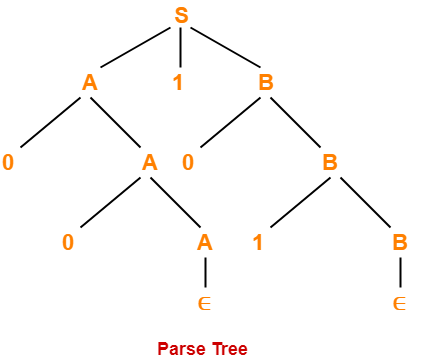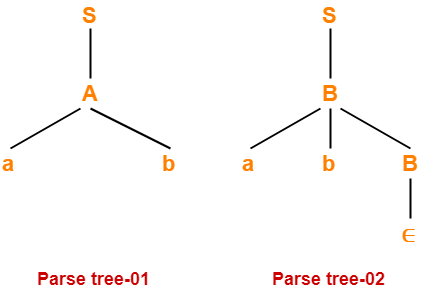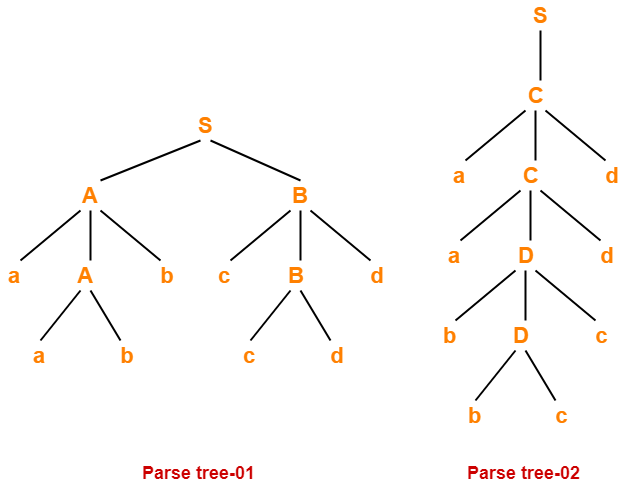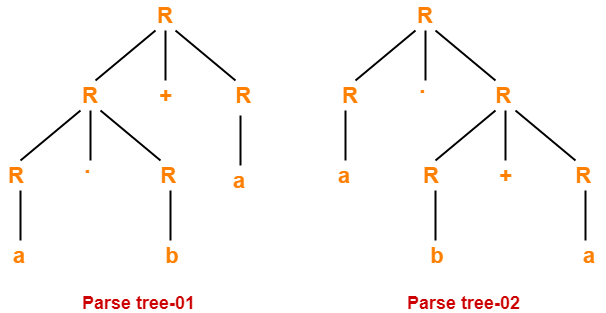Parse Tree-
- The process of deriving a string is called as derivation.
- The geometrical representation of a derivation is called as a parse tree or derivation tree.

1. Leftmost Derivation-
- The process of deriving a string by expanding the leftmost non-terminal at each step is called as leftmost derivation.
- The geometrical representation of leftmost derivation is called as a leftmost derivation tree.
Example-
Consider the following grammar-
S → aB / bA
S → aS / bAA / a
B → bS / aBB / b
(Unambiguous Grammar)
Let us consider a string w = aaabbabbba
Now, let us derive the string w using leftmost derivation.
Leftmost Derivation-
S → aB
→ aaBB (Using B → aBB)
→ aaaBBB (Using B → aBB)
→ aaabBB (Using B → b)
→ aaabbB (Using B → b)
→ aaabbaBB (Using B → aBB)
→ aaabbabB (Using B → b)
→ aaabbabbS (Using B → bS)
→ aaabbabbbA (Using S → bA)
→ aaabbabbba (Using A → a)

2. Rightmost Derivation-
- The process of deriving a string by expanding the rightmost non-terminal at each step is called as rightmost derivation.
- The geometrical representation of rightmost derivation is called as a rightmost derivation tree.
Example-
Consider the following grammar-
S → aB / bA
S → aS / bAA / a
B → bS / aBB / b
(Unambiguous Grammar)
Let us consider a string w = aaabbabbba
Now, let us derive the string w using rightmost derivation.
Rightmost Derivation-
S → aB
→ aaBB (Using B → aBB)
→ aaBaBB (Using B → aBB)
→ aaBaBbS (Using B → bS)
→ aaBaBbbA (Using S → bA)
→ aaBaBbba (Using A → a)
→ aaBabbba (Using B → b)
→ aaaBBabbba (Using B → aBB)
→ aaaBbabbba (Using B → b)
→ aaabbabbba (Using B → b)

NOTES
|
Here,
- The given grammar was unambiguous.
- That is why, leftmost derivation and rightmost derivation represents the same parse tree.
| Leftmost Derivation Tree = Rightmost Derivation Tree |
Also Read- Ambiguous Grammar
Properties Of Parse Tree-
- Root node of a parse tree is the start symbol of the grammar.
- Each leaf node of a parse tree represents a terminal symbol.
- Each interior node of a parse tree represents a non-terminal symbol.
- Parse tree is independent of the order in which the productions are used during derivations.
Yield Of Parse Tree-
- Concatenating the leaves of a parse tree from the left produces a string of terminals.
- This string of terminals is called as yield of a parse tree.
PRACTICE PROBLEMS BASED ON DERIVATIONS AND PARSE TREE-
Problem-01:
Consider the grammar-
S → bB / aA
A → b / bS / aAA
B → a / aS / bBB
For the string w = bbaababa, find-
- Leftmost derivation
- Rightmost derivation
- Parse Tree
Solution-
1. Leftmost Derivation-
S → bB
→ bbBB (Using B → bBB)
→ bbaB (Using B → a)
→ bbaaS (Using B → aS)
→ bbaabB (Using S → bB)
→ bbaabaS (Using B → aS)
→ bbaababB (Using S → bB)
→ bbaababa (Using B → a)
2. Rightmost Derivation-
S → bB
→ bbBB (Using B → bBB)
→ bbBaS (Using B → aS)
→ bbBabB (Using S → bB)
→ bbBabaS (Using B → aS)
→ bbBababB (Using S → bB)
→ bbBababa (Using B → a)
→ bbaababa (Using B → a)
3. Parse Tree-

- Whether we consider the leftmost derivation or rightmost derivation, we get the above parse tree.
- The reason is given grammar is unambiguous.
Problem-02:
Consider the grammar-
S → A1B
A → 0A / ∈
B → 0B / 1B / ∈
For the string w = 00101, find-
- Leftmost derivation
- Rightmost derivation
- Parse Tree
Solution-
1. Leftmost Derivation-
S → A1B
→ 0A1B (Using A → 0A)
→ 00A1B (Using A → 0A)
→ 001B (Using A → ∈)
→ 0010B (Using B → 0B)
→ 00101B (Using B → 1B)
→ 00101 (Using B → ∈)
2. Rightmost Derivation-
S → A1B
→ A10B (Using B → 0B)
→ A101B (Using B → 1B)
→ A101 (Using B → ∈)
→ 0A101 (Using A → 0A)
→ 00A101 (Using A → 0A)
→ 00101 (Using A → ∈)
3. Parse Tree-

- Whether we consider the leftmost derivation or rightmost derivation, we get the above parse tree.
- The reason is given grammar is unambiguous.
To gain better understanding about Derivations and Parse Tree,
Next Article- Elimination of Left Recursion
Get more notes and other study material of Theory of Automata and Computation.
Watch video lectures by visiting our YouTube channel LearnVidFun.








